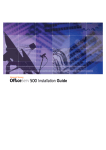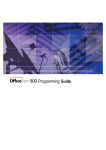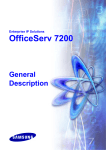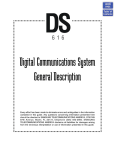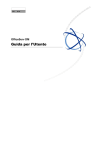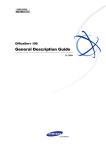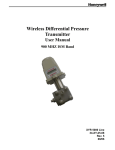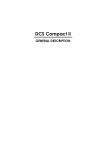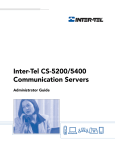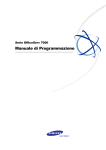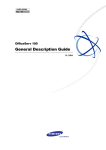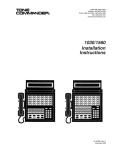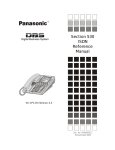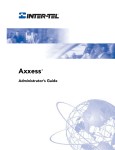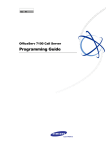Download Boss Audio Systems OfficeServ 12 User's Manual
Transcript
f 12 General Description Guide COPYRIGHT This manual is proprietary to SAMSUNG Electronics Co., Ltd. and is protected by copyright. No information contained herein may be copied, translated, transcribed or duplicated for any commercial purposes or disclosed to third parties in any form without the prior written consent of SAMSUNG Electronics Co., Ltd. TRADEMARKS OfficeServ 12 is the trademark of SAMSUNG Electronics Co., Ltd. Product names mentioned in this document may be trademarks and/or registered trademarks of their respective companies. Please read this guide before using the OfficeServ 12, and follow the instructions to use the OfficeServ 12 safely and correctly. This manual may be changed for the product improvement, standardization and other technical reasons without prior notice. For further information on the updated manual or the content contained in the manual, contact your Authorized Samsung Reseller. INTRODUCTION About this manual OfficeServ 12, Enterprise IP Solutions System, is a digital telephone system designed for small to medium-sized businesses. This manual provides an overview of the Samsung OfficeServ 12, Enterprise IP Solutions System, including system structure and hardware, features and facilities and specifications. This guide consists of the following chapters. 9 Introduction to System 9 Hardware Descriptions 9 Specifications 9 Business Feature Package Supporting Documents Further detail on all of the aspects covered in this manual is included in the system Installation and Programming guide. The OfficeServ 12 system provides the following manuals for more information : 9 General Description Guide This manual provides an overview of the Samsung OfficeServ 12, Enterprise IP Solutions System, including system structure and hardware, features and facilities and specifications. 9 Installation Guide This manual provides the information about installation of the Samsung OfficeServ 12, Enterprise IP Solutions System, including information about connecting the equipment. 9 Programming Guide OfficeServ 12 system provides MMC(Man Machine Communication) program. Users can configure the system using the MMC program at the digital telephone. This manual describes how to use the MMC program. © SAMSUNG Electronics Co., Ltd. Page I OfficeServ 12 General Description Guide/Ed.01 Introduction Conventions The following special paragraphs are used in this document to point out information that must be read. This information may be set-off from the surrounding text, but is always preceded by a bold title in capital letters. The three categories of these special paragraphs are : CAUTION Indicate a potentially hazardous situation which if not avoided, may result in minor or moderate injury. It may also be used to alert against unsafe practices. NOTE Indicates additional information as a reference Console Screen Output 9 The lined box with ‘Courier New’ font will be used to distinguish between the main content and console output screen text. 9 ‘Bold Courier New’ font will indicate the value entered by the operator on the console screen Revision History EDITION DATE OF ISSUE REMARKS 00 7. 2003. First Version © SAMSUNG Electronics Co., Ltd. Page II SAFETY CONCERNS For product safety and correct operation, the following information must be given to the operator/user and shall be read before the installation and operation. Symbols Caution Indication of a general caution Restriction Indication for prohibiting an action for a product Instruction Indication for commanding a specifically required action CAUTION CAUTION Barge-In without tone may violate laws concerning the right to privacy. SAMSUNG Electronics CO. is in no way responsible for the possible misuse of this feature. © SAMSUNG Electronics Co., Ltd. Page III OfficeServ 12 General Description Guide/Ed.01 SAFETY CONCERNS This page is intentionally left blank. © SAMSUNG Electronics Co., Ltd. Page IV TABLE OF CONTENTS INTRODUCTION About this manual ................................................................................................................ I Supporting Documents......................................................................................................... I Conventions ........................................................................................................................ II Console Screen Output ....................................................................................................... II Revision History .................................................................................................................. II SAFETY CONCERNS Symbols ..............................................................................................................................III CAUTION ...........................................................................................................................III CHAPTER 1 Business Feature Package 1 SYSTEM FEATURES ...................................................................................................... 4-2 1.1 SYSTEM FEATURE DESCRIPTIONS..................................................................... 4-5 2 STATION FEATURES .................................................................................................... 4-31 2.1 STATION FEATURE DESCRIPTIONS .................................................................. 4-32 3 DISPLAY FEATURES .................................................................................................... 4-40 3.1 DISPLAY FEATURE DESCRIPTIONS................................................................... 4-41 © SAMSUNG Electronics Co., Ltd. Page V OfficeServ 12 General Description Guide/Ed.01 Table of Contents This page is intentionally left blank. © SAMSUNG Electronics Co., Ltd. Page VI Business Feature Package This chapter describes various features of the OfficeServ 12 system as follows: 9 SYSTEM FEATURES 9 STATION FEATURES 9 DISPLAY FEATURES 9 SAMPLE SMDR PRINTOUT(WITHOUT CALLER ID) 9 SAMPLE SMDR PRINTOUT(WITH CALLER ID NUMBER) 9 SAMPLE UCD REPORT 9 UCD CALL STATISTICS 9 UCD AGENT STATISTICS 9 SAMPLE TRAFFIC REPORT 9 TRAFFIC REPORT OVERVIEW 9 SAMPLE ALARM REPORT © SAMSUNG Electronics Co., Ltd. Page 4-1 OfficeServ 12 General Description Guide/Ed.01 1 CHAPTER 4. Business Feature Package SYSTEM FEATURES Account Code Entry Forced-Verified Forced-Not Verified Call Forwarding All Calls Busy Voluntary Account Code Button No Answer Busy/No Answer All Call Voice Page Forward DND Attention Tone Authorization Codes Follow Me Forced Voluntary Auto Attendant† Automatic Hold Background Music Boss/Secretary Service Executive Answer Mode Executive Status To Voice Mail Preset Destination Call Forward Busy(CFB-Networking Enabled Only) Call Forward No Response(CFNR-Networking Enabled Only) Call Forward Unconditional (CFU-Networking Enabled Only) Call Hold Exclusive System Remote Divert Cadence - Integrated Voice Mail* Call Activity Display† Call Park and Page Call Pickup Call Costing† Caller Identification† Groups Call Waiting/Camp-On Caller ID Calling Line Identification(CLI) Caller ID Features Directed Caller Emergency Service ID(CESID) Centrex/PBX Use Chain Dialing Name/Number Display Next Call Save Caller ID Number Store Caller ID Number Inquire Park/Hold Caller ID Review List Investigate Abandon Call List Page All Caller ID on SMDR Number to Name Translation Park Orbits Primeline Selection Class of Service Private Lines Common Bell Control Conference Programmable Line Privacy Programmable Timers Add On(5 Party) Programmed Message Service Unsupervised Split Recalls Remote Programming-PC Computer Telephony Integration(CTI) TAPI 2.1 Customer Set Relocation © SAMSUNG Electronics Co., Ltd. Page 4-2 OfficeServ 12 General Description Guide/Ed.01 Data Security CHAPTER 4. Business Feature Package Ring Modes Database Printout Time Based Routing Dialed Number Identification Service(DNIS) Direct In Lines Automatic/Manual Direct Inward Dialing(DID) Time-based Routing Busy or Camp-On Option Holiday Schedule Temporary Override Ring Over Page Secretary Pooling Direct Inward System Access(DISA) Single Line Connections Direct Trunk Selection Directory Names Speed Dial Numbers DISA Security Distinctive Ringing Door Lock Release(Programmable) Station List(50 Max) System List(500 Max) Speed Dial by Directory Spot View Interface Door phones Spot Call Plus Easyset Interface Executive Barge-In(Override) Spot News With Warning Tone Without Warning Tone Trunk Monitor or Service Observing External Music Interfaces Spot Choice Station Hunt Groups Distributed Sequential Unconditional External Page Interfaces Station Message Detail Recording(SMDR) Flash Button Operation Flexible Numbering System Alarms Hot Line System Directory Group Conference In Group/Out of Group Tenant Services Incoming Call Distribution Toll Restriction System Maintenance Alarms Text Message Service Incoming/Outgoing Service Individual Line Control Time of Day IP phone Interface Eight Dialing Classes By Line or Station Special Code Table ISDN Service Basic Rate Interface(BRI) Toll Restriction Override Least Cost Routing Tone or Pulse Dialing Live System Programming Traffic Reporting From any Display phone With a Personal Computer Transfer Screened/Unscreened Meet Me Page and Answer Voice Mail Transfer Button Memory Protection Message Waiting Indications With Camp-On Trunk Groups Microphone On/Off per Station Universal Answer Music on Hold-Flexible Music on Hold-Sources Virtual Port © SAMSUNG Electronics Co., Ltd. Page 4-3 OfficeServ 12 General Description Guide/Ed.01 CHAPTER 4. Business Feature Package Operator Group Voice Dialing Overflow Voice Mail-Inband Integration Operator Station Group VoIP Networking VoiP Trunk Interface(H.323/SIP) Override Code Walking Class of Service Paging Wireless LAN Service Internal Zones(4) External Zones(2) All Internal All External * Requires optional hardware and/or software. Ask your dealer for details. © SAMSUNG Electronics Co., Ltd. Page 4-4 OfficeServ 12 General Description Guide/Ed.01 1.1 CHAPTER 4. Business Feature Package SYSTEM FEATURE DESCRIPTIONS 1.1.1 Account Code Entry Station users may enter an account code(maximum 12 digits) before hanging up from a call. This account code will appear in the SMDR printout for that call record. phone users may enter this code using an account code button without interrupting a conversation. Single line telephone users must temporarily interrupt the call by hookflashing and dialing the feature access code. Manually entered account codes can be up to 12 digits long. In some cases users can be forced to enter an account code and this account code may or may not be verified as described below. Forced-Verified When set for this option the user must enter an account code for all outgoing calls. The account code entered will be verified from a system list of 200 entries . Forced Verified codes can contain the digits 0~9. Forced-Not Verified When set for this option the user must enter an account code for all outgoing calls, but the account code is not verified against the system list. Non verified account codes can contain the digits 0~9 and #. Voluntary In this case account codes are not required to make outgoing calls but may be used if desired. This is also the method used to assign an account code to incoming calls. These account codes can contain the digits 0~9 and #. 1.1.2 All Call Voice Page Users can page all internal and all external paging zones at the same time by dialing the All Page code. phones may be restricted from making or receiving pages in system programming. A maximum of 16 phones can be programmed in each internal page zone to receive page announcements. 1.1.3 Attention Tone To get your attention, a brief tone precedes all page announcements and intercom voice calls. There are separate programmable duration timers for page and voice announce tones. 1.1.4 Authorization Codes Authorization codes are used to give permission to make a call. A maximum of 100 four to ten-digit authorization codes can be either forced or voluntary. When used, © SAMSUNG Electronics Co., Ltd. Page 4-5 OfficeServ 12 General Description Guide/Ed.01 CHAPTER 4. Business Feature Package authorization codes will automatically change the dialing station’s class of service to the level assigned to the authorization code. Authorization codes may be programmed to print or not print on SMDR. FORCED When a station is programmed for forced authorization, the user must always enter this code before dialing is allowed. The dialed authorization code is verified from the system list of 100 authorization codes. VOLUNTARY Any station user can always enter an authorization code before they begin dialing. The dialed authorization code is verified from a system list of 100 authorization codes. 1.1.5 Automatic Hold While a phone user is engaged on an outside(Trunk line) call, pressing another trunk button, route button or CALL button automatically places the call on hold when Automatic Hold is enabled. Pressing TRSF, CONFERENCE, PAGE or a DSS button always automatically places a Trunk line call on hold. Intercom calls can be automatically held only by pressing TRSF or CONFERENCE. Each phone user can enable or disable Automatic Hold. 1.1.6 Background Music phone users may choose to hear music through their phone speakers when optional external sources are installed. Each user may adjust this level by the use of a volume control program at the selected phone. 1.1.7 Boss/Secretary Service Up to four secretaries can be assigned to an executive. The line designated as the executive may not be assigned as a secretary of another executive. When the executive is busy or in DND status, the call is automatically connected to the secretary. Executive Answer Mode The secretary can set the response mode for each executive. The response modes include Ring Mode, Automatic Answer, and Voice Announce. Executive Status The status of an executive can be set by the executive or the secretary. Other persons can verify the set status through Easyset Application. © SAMSUNG Electronics Co., Ltd. Page 4-6 OfficeServ 12 General Description Guide/Ed.01 CHAPTER 4. Business Feature Package Divert Divert may only be set from the line designated as an executive. Press the [Divert] button in idle mode to automatically transfer all incoming calls to the secretary. Press the [Divert] button while ringing to transfer the incoming call to the secretary. The Divert function is operated by a toggle button. 1.1.8 Call Activity Display The OfficeServ 12 will record and buffer all calling activity within the system. With a Call Activity Display(CAD) button, the OfficeServ 12 will display a ‘snapshot’ of the following information : 9 9 9 9 9 9 The maximum number of ports that have been used The maximum number of trunks that have been used The maximum number of stations that have been used The current number of ports in use The current number of trunks in use The current number of stations in use 1.1.9 Call Costing The OfficeServ 12 provides programmable call costing tables to calculate the cost of incoming and outgoing calls. Rates are calculated by the number dialed, and may include surcharges. Display phones can be set to show the call duration timer or the call cost. The SMDR report will show either the call duration or the call cost depending on the station selection. One call handled by multiple callers will cost each call segment separately. 1.1.10 Caller Identification The OfficeServ 12 supports three methods of identifying an incoming caller depending on the circuit type as described below. Caller ID On an analog, loop start CO line, calling party information is called Caller ID and is available from the telephone company in two formats, Number only and Name and Number, sometimes called Deluxe. The OfficeServ 12 is compatible with both formats. Even if the telephone company only offers the number only, a name can be attached to the telephone number of frequent callers via the CID translation table. Calling Line Identification (CLI) On ISDN circuits, calling party information is called CLI and is supported on both BRI and PRI type circuits as described below. On ISDN circuits the OfficeServ 12 only supports Number delivery and a name can © SAMSUNG Electronics Co., Ltd. Page 4-7 OfficeServ 12 General Description Guide/Ed.01 CHAPTER 4. Business Feature Package be attached to the telephone number of frequent callers via the CID translation table. Caller ID Features The following features apply to all forms of Caller Identification, however, to make them easier to read caller identification is referred to as Caller ID. Name/Number Display Each LCD phone user can decide if he/she wants to see the name or number in the display. Regardless of which one is selected to be seen first, the NND button is pressed to view the other pieces of information. Next Call In the event that you have a call waiting or a camped-on call at your phone, you can press the NEXT button to display the Caller ID information associated with this next call in queue at your station. Either the Caller ID name or number will show in the display depending on your selection. Save Caller ID Number At any time during an incoming call that provides Caller ID information, you may press the SAVE button. This saves the Caller ID number in the Save Number feature. Pressing the SAVE number redial button will dial the Caller ID number. The system must be using Least Cost Routing(LCR) to dial the saved number. Store Caller ID Number At any time during an incoming call that provides Caller ID information, you may press the STORE button. This saves the Caller ID number as a speed dial number in your personal speed dial list. The system must be using LCR to dial the stored number. Inquire Park/Hold Having been informed that an incoming call is on hold or has been parked, you may view the Caller ID information before you retrieve the call. This will influence how you choose to handle the call. Caller ID Review List This feature allows display phone users to review Caller ID information for calls sent to their stations. This list can be from ten to fifty calls in a first in, first out basis. The list includes calls that you answered and calls that rang your station but that you did not answer. When reviewing this list, you can press one button to dial the person back. © SAMSUNG Electronics Co., Ltd. Page 4-8 OfficeServ 12 General Description Guide/Ed.01 CHAPTER 4. Business Feature Package The system must be using LCR to dial the stored number. If CID REVW ALL in the User ON/OFF option set to OFF, only calls that are not answered(missed calls) at the station will be recorded in the Review list. Investigate This feature allows selected stations with a special class of service to investigate any call in progress. If Caller ID information is available for an incoming call, you will know to whom this station user is speaking. On outgoing calls, you can see who was called. After investigating, you may barge-in on the conversation, disconnect the call or hang up. Abandon Call List The system has a system-wide abandon call list that stores Caller ID information for calls that rang but were not answered. The list is accessed using the administrator’s passcode. When reviewing this list, you are provided options to CLEAR the entry or DIAL the number. You can see the NND button to toggle between the Caller ID name, number and the date and time the call came in. The system must be using LCR to dial numbers from the abandon call list. The abandoned call list will store up to 100 unanswered calls. Caller ID on SMDR The Station Message Detail Records report can be set to include Caller ID name and Caller ID number for incoming calls. This format expands the printout to 113 characters. Use a wide carriage printer or an 80 column printer set for condensed print. Number to Name Translation The system provides a translation table for 1000 entries. When the Caller ID number is received, the table is searched. When a match is found, the system will display the corresponding name. 1.1.11 Call Forwarding This feature allows the user to redirect(forward) incoming calls. The calls can be redirected to the attendant, a hunt group, voice mail, external number or another station user. If the destination station is in Do Not Disturb(DND), the calling party will receive DND/Reorder tone. Calls cannot be forwarded to a door phone. The external number can be set to the forward destination for all kinds of forwarding. So External, CFB, CFNR and CFU option is removed. When the destination is external number, the ICM EXT FWD option must be set to ON. If not, the call forwarding does not accomplished. ALL CALLS © SAMSUNG Electronics Co., Ltd. Page 4-9 OfficeServ 12 General Description Guide/Ed.01 CHAPTER 4. Business Feature Package This type of forwarding is not affected by the condition of the station. All calls are immediately redirected to the designated destination. If desired, the destination station may redirect the call back to the forwarded station by using the transfer feature. The forwarded station user can continue to originate calls as usual. If no button is programmed as Forward All, the TRSF button lights steady when a Forward All condition is set. BUSY This feature forwards all calls only when the station set is busy. The station user can originate calls as usual. NO ANSWER This feature forwards calls that are not answered within a preprogrammed time. The user can originate calls as usual and receive call if present. The timer is programmable on a per-station basis to allow for differences in individual work habits. BUSY/NO ANSWER This feature allows the station user to use both types of forwarding simultaneously, provided the destinations have already been entered in the usual manner. FORWARD DND This feature works with the Do Not Disturb feature. This allows calls directed to a station in Do Not Disturb or One Time Do Not Disturb to forward immediately to another destination. FOLLOW ME This feature allows the user to forward all calls from another station to the user’s station or change the forward destination to the user’s current location. TO VOICE MAIL Each station may be programmed to allow or deny the ability to forward intercom calls to voice mail. When denied, valuable message time in the voice mail system can be saved. PRESET DESTINATION If desired this feature provides for a permanent(preset) forward no answer destination for each extension. It can only be programmed by the system technician or system administrator. When any station does not have FWD/NO-ANSWER set, the call will ring this preset destination if one is programmed. Call Forward Busy (CFB) (networking enabled only) This is a different feature from the normal call forward busy and is only used when © SAMSUNG Electronics Co., Ltd. Page 4-10 OfficeServ 12 General Description Guide/Ed.01 CHAPTER 4. Business Feature Package the forward destination is in a different node of the network. The operation of the feature is the same as the normal forward busy where when the forwarded station is busy a calling station will be forwarded to the forward destination. Call Forward No Response (CFNR) (networking enabled only) This is a different feature from the normal call forward no answer and is only used when the forward destination is in a different node of the network. The operation of the feature is the same as the normal forward no answer where when the forwarded station does not answer after a programmed amount of time a calling station will be forwarded to the forward destination. Call Forward Unconditional (CFU) (networking enabled only) This is a different feature from the normal call forward all and is only used when the forward destination is in a different node of the network. The operation of the feature is the same as the normal forward all where all calls to the forwarded station will be forwarded to the forward destination. 1.1.12 Call Hold (Exclusive) Outside calls can be placed on exclusive hold at any phone by pressing HOLD twice during a call. Calls placed on exclusive hold can only be retrieved at the phone that placed the call on hold. Intercom calls are always placed on exclusive hold. 1.1.13 Call Hold (System) Outside calls can be placed on system hold at any station. Users may dial the access code or press the HOLD button. Calls on system hold may be retrieved at any station. 1.1.14 Call Hold (Remote) Outside calls can be placed on hold at a remote station. This feature allows calls to be answered at one phone and placed on hold at another station. This allows time for the user to proceed to that station or allows the party that the call was intended for to have that call placed at their station. The call or trunk button will flash at the remote hold station. Intercom calls cannot be remote held. 1.1.15 Call Park and Page Each Trunk line has its own park zone. This simple method eliminates confusion and ensures that a park zone is always available. Pressing the PAGE button parks the call © SAMSUNG Electronics Co., Ltd. Page 4-11 OfficeServ 12 General Description Guide/Ed.01 CHAPTER 4. Business Feature Package automatically. There are no extra buttons to press and there is no lost time looking for a free zone. 1.1.16 Call Pickup DIRECTED With directed call pickup, users can answer calls ringing at any station by dialing a code plus that station’s extension number or by pressing the feature button and then dialing the extension. GROUPS In addition, calls can be picked up from a station group in a similar manner. The group pickup feature allows users to answer any call ringing within any pickup group. There are 10 pickup groups available. A station cannot be in more than one pickup group. To use this feature, station users either dial the access code or press the assigned feature button followed by the pickup group number. 1.1.17 Call Waiting/Camp-on Busy stations are notified that a call is waiting(camped-on) when they receive a tone. The tone is repeated at a programmable interval. phones receive an off-hook ring signal through the speaker and single line stations receive a tone in the handset. The volume of the camp-on tone can be set by the station user. Camped-on calls follow Forward No Answer if a Forward No Answer destination has been set. Optionally any station can be programmed to automatically camp-on to a busy station instead of having to press the camp-on button or dial a camp-on code. 1.1.18 Centrex/PBX Use CENTREX and PBX lines can be installed in lieu of central office trunks. CENTREX and PBX feature access codes including the command for hook-flash (FLASH) can be stored under one touch buttons. Toll restriction programming can ignore PBX or CENTREX access codes so that toll calls can be controlled when using these services. 1.1.19 Chain Dialing phone users may manually dial additional digits following a speed dial call or chain together as many speed dial numbers as are required. 1.1.20 Class of Service The system allows a maximum of 30 station classes of service. Each class of service can be customized in memory to allow or deny access to features and to define a © SAMSUNG Electronics Co., Ltd. Page 4-12 OfficeServ 12 General Description Guide/Ed.01 CHAPTER 4. Business Feature Package station’s dialing class. Each station can be assigned different classes of service for day and night operation. 1.1.21 Common Bell Control The system provides relay that may be programmed to control a customer-provided common bell or common audible device. These contact must be programmed as member of a station group and may provide steady or interrupted closure. 1.1.22 Conference The system allows six simultaneous conferences up to 5 parties each. ADD-ON (5 PARTY) Any combination of up to five parties(stations or outside lines) can be joined together in an add-on conference. Parties may be eliminated or added after a conference has been established. UNSUPERVISE A station user may set up a conference with two or more outside lines and then exit the conference leaving the outside lines connected in an unsupervised(trunk to trunk) conference. SPLIT A phone user can ‘split’ a conference into separate outside calls, then speak with each caller privately. Then the individual calls can be conferenced again in any combination. This feature requires individual trunk buttons and auto-hold must be enabled. 1.1.23 Computer Telephony Integration (CTI) Computer Telephone Integration(CTI) allows integration between the OfficeServ 12 and a personal computer system(PC) or a local area network(LAN). Caller ID service is required for TAPI inbound call applications that use the CID information to display computer records in conjunction with the presentation of the call to the station on the OfficeServ 12. TAPI 2.1 TAPI 2.1 is the method of integrating the OfficeServ 12 system to a computer. TAPI 2.1 is a LAN based solution allowing computers to communicate directly to the telephone system over the network system. This establishes a logical connection © SAMSUNG Electronics Co., Ltd. Page 4-13 OfficeServ 12 General Description Guide/Ed.01 CHAPTER 4. Business Feature Package rather than a physical connection between telephone and computer. It eliminates the cost and administrative overhead of connecting every PC to a desktop phone. It emphasizes third-party call control. E.g.,) Calls can be tracked as they are transferred, making it more suited to large office applications. TAPI 2.1 can emulate first-party type call control for the OfficeServ 12 system, rather than from the telephone as TAPI 2.0 does. For example, to make a call the OfficeServ 12, rather than the telephone would dial the phone number, and the call would be then transferred to the telephone. 1.1.24 Customer Set Relocation Customer Set Relocation allows the customer to exchange or swap similar stations in the OfficeServ 12 without wiring changes. All individual station assignments such as trunk ring, station group, station COS, station speed dial, button appearances, call forwarding, etc. will follow the Customer Set Relocation program. 1.1.25 Data Security Single line extensions used with modems and facsimile machines can be programmed so that they will not receive any system-generated tones that would disrupt data transmissions. In addition, these devices receive DCS Trunk line ringing pattern instead of intercom ring pattern. Devices connected to an SLI card receive a disconnect signal upon termination. 1.1.26 Database Printout A copy of the customer database can be obtained by using PCMMC. This information can be directed to a printer or the PC screen and may be done either on-site or remotely. A complete database or specific data blocks may be obtained. 1.1.27 Dialed Number Identification Service (DNIS) When DNIS service is provided on an incoming trunk the OfficeServ 12 can route calls based on the numbers received. 1.1.28 Direct in Lines Outside lines may be programmed to bypass the operator(s) and ring directly at any station or group of stations. © SAMSUNG Electronics Co., Ltd. Page 4-14 OfficeServ 12 General Description Guide/Ed.01 CHAPTER 4. Business Feature Package 1.1.29 Direct Inward System Access (DISA) Users can call in on specific DISA lines at any time, input a security code and receive system dial tone. Users can now place internal calls or if permitted, calls using Trunk lines. The caller must have a tone dial phone and know his/her DISA security code. DISA lines can be used as both way lines or incoming only and may be active in day mode, night mode or both. The Trunk lines used for DISA must have disconnect supervision. The requirement to put in a DISA security code can be disabled if desired. 1.1.30 Direct Trunk Selection Each station can be allowed access to or denied access from a trunk or trunk group by access code when LCR is activated. When restricted, the station user must use a trunk button or a route button. 1.1.31 Directory Names Each station, station group and Trunk line may be assigned a directory name (maximum 11 characters). In addition, each personal speed dial number, system speed dial number and entry in the DID translation table may be assigned a name (maximum 11 characters). These names are displayed during calls with these ports and in the case of station and speed dial names, can be used to originate calls. See the Dial by Name feature(Station Features). 1.1.32 Disa Security Telephone fraud and long distance theft are a serious concern. The OfficeServ 12 provides a strong DISA security system. If an incorrect DISA passcode is entered repeatedly(as is the case with ‘hackers’), the DISA system can be automatically disabled temporarily. Both the number of incorrect passcode attempts and the time that DISA is disabled are programmable. In addition, all failed attempts to access DISA print on SMDR(if provided) with a ‘DE’ DISA error flag. 1.1.33 Distinctive Ringing A user knows the type of call received by the type of ring heard. Outside calls have a single ring repeated while internal calls have a double ring repeated. In addition any trunk or station can be programmed to ring a phone with a predefined ring tone(1-8) or a single line port with a predefined cadence(1-5) selection. This provides for easy identification of special lines or extensions that ring your phone. © SAMSUNG Electronics Co., Ltd. Page 4-15 OfficeServ 12 General Description Guide/Ed.01 CHAPTER 4. Business Feature Package 1.1.34 Door Lock Release (Programmable) After answering a call from the door phone, users can dial a code to activate a contact closure. This can be used to operate a customer-provided electric door lock release mechanism. The contact closure timer is programmable from 100-2500 ms. 1.1.35 Door phones The door phone interface module(DPIM) provides for connection of a door phone to a DLI port. Pressing the button on the door phone produces a distinctive ring(three short rings repeated) at the assigned station or station group. If not answered within a programmable time, the system releases the door phone and stops the ringing. Stations may call the door phone directly and monitor the surrounding areas. Door phones follow the system ring mode plan. 1.1.36 Easyset Interface Easyset Interface supports the interlocking of Easyset Application. Easyset Application is used for easily setting the buttons and functions of the digital/IP phone through the PC. Various convenient features such as the Short Message Service(SMS) and diary are added to the Easyset Application. 1.1.37 Executive Barge-in (Override) The feature allows specially programmed stations with a barge-in button to override the automatic privacy of another station or outside trunk. Programming allows bargein with or without a warning tone. Stations may also be programmed as ‘secure’ so that they cannot be barged-in on. WITH WARNING TONE When the barge-in with tone option is set, the barging-in phone has its microphone on and the barged-in on station receives an override display. A double burst of warning tone sounds and repeats every ten seconds. This feature does not work from single line sets. WITHOUT WARNING TONE When the barge-in without tone option is set, the barging-in phone has its microphone muted and the barged-in on station does not receive an override display. This feature does not work from single line sets. TRUNK MONITOR or SERVICE OBSERVING This feature allows the user who barged-in to retain the trunk call after the original station has hung up. © SAMSUNG Electronics Co., Ltd. Page 4-16 OfficeServ 12 General Description Guide/Ed.01 CHAPTER 4. Business Feature Package Barge-In without tone may violate laws concerning the right to privacy. SAMSUNG Electronics co. is in no way responsible for the possible misuse of this feature. 1.1.38 Executive/Secretary Pooling Each phone may be defined as an executive(BOSS in programming) or a secretary(SECR in programming) in system programming. Each executive can have up to four secretaries and each secretary can have up to four executives. These arrangements are known as executive/secretary pools. There can be multiple pools in a system. When an executive is in DND, all calls to the executive ring the first secretary assigned to that executive; if that secretary is busy, the call hunt to the next available secretary assigned to that executive. If the secretary must communicate with the executive while he/she is in DND, pressing the corresponding executive button on the secretary’s phone results in an Auto Answer intercom call being made to the executive(providing the executive is free). The OfficeServ 12 software has a system wide option to allow the stations to ring rather than auto announce the executive secretary calls. A station can only be the executive of one secretary pool. In addition, a station cannot be in more than one pool. 1.1.39 External Music Interfaces The system provides one input for connecting to customer provided external music sources. 1.1.40 External Page Interfaces The OfficeServ 12 have a MISC module internally provides one external page output and one zone control relay. Resources can be combined to provide two external zones. Relay may be assigned to one zone. 1.1.41 Flash Button Operation While a user is on an outside line, pressing the FLASH button will flash the central office or PBX. This is used for custom calling features on Trunk lines or in conjunction with CENTREX/PBX operation. System programming allows individual flash times for Trunk line and PBX lines. When Trunk line or PBX flash is not required, setting the timers for two seconds releases the existing call and returns dial tone to make a new call. 1.1.42 Flexible Numbering System programming allows stations to have two, three or four digit extension numbers beginning with the digit 2 or 3. Three digit default extension numbers begin © SAMSUNG Electronics Co., Ltd. Page 4-17 OfficeServ 12 General Description Guide/Ed.01 CHAPTER 4. Business Feature Package with 201. Station group numbers can be three digits beginning with the digit 5. Using digits other than 2, 3 or 5 will require the technician to change other feature access codes in the system default numbering plan. User guides will need to be modified as these are all written using the OfficeServ 12 default numbering plan. 1.1.43 Hot Line Stations can be programmed to call a pre-defined station or station group whenever that station goes off-hook. A hot line delay timer of 0-250 seconds can be programmed to allow sufficient time to make a different call. 1.1.44 Group Conference The GCONF button is used to automatically call the preset number and include the person into the conference when he or she answers the call. This function may only be used for preset extensions, and up to five conference groups can be assigned to an extension. Up to five persons, including the user may be assigned to a conference group. The Trunk line, which can identify if the other party answers the call, shall be used to ensure normal service when calling external numbers. 1.1.45 In Group/Out of Group Individuals assigned to a station hunt group may temporarily remove their telephones from the group by pressing the In/Out of Group button providing that there is someone still in the group. The OfficeServ 12 has a system wide option to allow all members to log out of a station group. Stations out of a group will not receive calls to that group but will continue to receive calls to their individual extension numbers. When desired, the user may put him/herself back into the group by pressing the button again. Users who do not have this button may dial the access code and the group desired. A station user is allowed to be in several groups, providing a button and the extender of that group are assigned for each group on the user’s phone. 1.1.46 Incoming Call Distribution Incoming calls can be assigned to ring a distributed station hunt group. This allows all members of the group to share the call load. 1.1.47 Incoming/Outgoing Service Outside lines are available for incoming or outgoing service. Programming allows any outside line to be used for incoming calls only, outgoing calls only or both way service. © SAMSUNG Electronics Co., Ltd. Page 4-18 OfficeServ 12 General Description Guide/Ed.01 CHAPTER 4. Business Feature Package 1.1.48 Individual Line Control Each station in the system can be individually programmed to allow or deny dialing out as well as allow or deny answering for each outside line. 1.1.49 IP phone Interface OfficeServ 12 supports IP phones. An additional Media Gateway Interface(MGI) port is not required for calls between Local IP phones, but a separate MGI card must be installed for calling an existing station. 1.1.50 ISDN Service Basic Rate Interface (BRI) The BRI card supports trunk or station level Basic Rate Interface services(BRI). Trunk or station BRI use is software programmable. BRI allows simultaneous data calls, called party and calling number identification, high speed call setup and disconnect are among the benefits of ISDN calling. The 2B+D configuration of ISDN allows call information to be delivered via the data channel(the ‘D’ of 2B+D) thus leaving the bearer channels(the ‘B’ of 2B+D) available for single use or combined use to provide a wider bandwidth for data and video. 1.1.51 Least Cost Routing Least Cost Routing(LCR) is the ability to automatically select the most cost effective central office route for the outside number dialed by any station. The OfficeServ 12 LCR program includes the following features : 9 9 9 9 9 9 9 9 Option to use or not use LCR or a tenant basis Programmable LCR access code Digit analysis table 2000 entries each with ten digits Routing by time of day and day of week(4 time bands per day) Routing according to individual station class Modify digits table 200 entries Flexible trunk group advance timer Option to use or not use trunk group advance warning tones 1.1.52 Live System Programming The system can be programmed from any display phone or personal computer without interrupting normal system operation. There are three levels of programming : technician, customer and station. The technician level has access to all programs and can allow the customer access to system programs as needed. Technician and customer access are controlled by different security passcodes. Programming from a PC requires the PCMMC program. © SAMSUNG Electronics Co., Ltd. Page 4-19 OfficeServ 12 General Description Guide/Ed.01 CHAPTER 4. Business Feature Package 1.1.53 Meet Me Page and Answer After a user makes a Meet Me Page, the user may remain off-hook to allow the paged party to meet the user for a private conversation. 1.1.54 Memory Protection In the event that power is lost to the system, all customer data contained in memory is retained by the use of a ‘super capacitor’ for approximately 7 days. In addition, the PCMMC computer program may be used to produce a backup copy of the customer data. 1.1.55 Message Waiting Indications When calling a station and receiving a busy signal or the no answer condition, the caller can leave an indication that a message is waiting. The message button will flash red at the messaged phone. A single line phone will receive a distinctive message waiting dial tone. Five message waiting indications can be left at any station. 1.1.56 Microphone on/Off Per Station The microphone can be disabled at any phone. When the microphone is disabled, the phone cannot use the speakerphone, although on-hook dialing and group listening are still possible. 1.1.57 Music on Hold-Flexible The OfficeServ 12 allows its music sources to be used in a very flexible manner as follows : Each phone can have a designated music source for playing as Background Music(BGM) through the phone speaker. Each Station can have a designated music source for playing to callers placed on Exclusive hold at that station. Each Trunk can have a designated music source for playing to callers placed on hold. This setting is overridden by some of the other settings such as station music on hold, DID MOH. Each entry in the DID translation table can have a designated music source to be played when a caller to that DID number is placed on hold. © SAMSUNG Electronics Co., Ltd. Page 4-20 OfficeServ 12 General Description Guide/Ed.01 CHAPTER 4. Business Feature Package 1.1.58 Music on Hold-Sources The OfficeServ 12 provides for up to four different types of Music on Hold source including silence or ‘NONE’ as listed below : None : No audio is played to the listener Tone : A tone is repeated at a programmable interval External source : An external source connected to a MISC module, such as a digital announcer or radio, is played to the listener. Voicemail Sound File : If the OfficeServ 12 system connect with SVM-400, up to 100 custom recorded sound files from the SVM-400 can be used for MOH sources. For information on creating the sound files see SVM-400 System Administrator Manual-Recording greeting by number. If you select this option be advised that each VMMOH source requires a dedicated SVM-400 port/channel. 1.1.59 Operator Group The operator group can contain 10 stations to answer incoming calls. Calls to this group can be set for distributed, sequential or unconditional ringing. Operators can use the In/Out of Group feature to meet flexible operator requirements. Operator groups are selectable per ring plan. 1.1.60 Overflow OPERATOR When calls ringing a operator group go unanswered, they can overflow to another destination after a programmed period of time. The operator group has its own timer. The overflow destination can be a station or station group. STATION GROUP When calls ringing a station group go unanswered, they can overflow to another destination after a programmed period of time. Each station group has its own timer. The overflow destination can be a station or station group. 1.1.61 Override Code This feature allows users to make emergency outside calls from a station that has a forced code such as Account code or authorization code enabled but without requiring them to enter a forced code. The basis of this feature is an override code table containing 8 entries of up to 14 digits each. The OfficeServ 12 will examine digits that are dialed from a station to see if they match any entry in the Emergency © SAMSUNG Electronics Co., Ltd. Page 4-21 OfficeServ 12 General Description Guide/Ed.01 CHAPTER 4. Business Feature Package Number table. If the digits match the table, the system will process the call without requiring a forced code. 1.1.62 Paging System software allows the use of four internal and four external paging zones. Stations can page any individual zone, all internal zones, all external zones or all zones simultaneously. Using system programming, each station may be allowed or denied the abilities to make and/or receive page announcements to any zone or combination of zones. 1.1.63 Park Orbits The system has 10 park orbits(0-9). These orbits can be used to park calls prior to paging and allows the call to be retrieved by dialing a park code plus the orbit number. Calls parked in this manner can also be retrieved by dialing the park pickup code plus the station or trunk number. This feature is in addition to Call Park and Page. 1.1.64 Prime Line Selection Any station can be programmed to select a specific line, trunk group, telephone number, station or station group when the handset is lifted or the speaker button is pressed(same as Hot Line feature). 1.1.65 Private Lines For private line use, stations can be prevented from dialing and/or answering any line. 1.1.66 Programmable Line Privacy Each outside line can be programmed to ignore the automatic line privacy. This allows up to four other parties to join your conversation by simply pressing the line button. This is similar to 1A2 button telephone operation. 1.1.67 Programmable Timers There are over 50 programmable system timers to allow each installation to be customized to best fit the end user’s application. 1.1.68 Programmed Message Service Programmed Messages can be set on each extension. The Programmed Messages are displayed on the LCD screen when call arrives from another extension. 15 messages are set at the system level and 5 messages are set separately for each extension. © SAMSUNG Electronics Co., Ltd. Page 4-22 OfficeServ 12 General Description Guide/Ed.01 CHAPTER 4. Business Feature Package 1.1.69 Recalls Calls put on hold, transferred or camped-on to any station will recall to the originating station if not answered within a programmable time. A recall that goes unanswered for the duration of the attendant recall timer will recall to the system operator group. Hold, transfer, camp-on and attendant recalls have individual programmable timers. Calls recalling to buttons with tri-colored LEDs will flash amber. 1.1.70 Remote Programming-PC Remote programming allows the technician to access the system database from a remote location for the purpose of making changes to the customer data. Customerprovided modems and a PC using an optional software package will be needed to implement this feature. 1.1.71 Ring Modes Time Based Routing-plans Each Trunk line can be programmed to ring at any station or station group. Each line can be assigned a ring destination based on six(6) different ring plans based on time of day and the day of the week. Automatic/Manual Ring destinations will automatically change based on time of day and day of week. At any time the system can be manually forced into a specific ring plan. It will remain in this ring plan until manually taken out. Holiday Schedule The system has a table of 60 dates that are used to define holidays. On a date designed as a holiday the system will remain in a ring plan for that calendar day providing the system was already in night service. This feature will override the ring plan time table. Temporary Override At any time the system can be forced into a specific ring plan for a temporary period of time until the next scheduled ring plan automatically takes effect. 1.1.72 Ring Over Page Any outside line can be programmed to ring over a customer-provided paging system. Outside lines, door phones and station groups may ring over page in the system ring plan mode. © SAMSUNG Electronics Co., Ltd. Page 4-23 OfficeServ 12 General Description Guide/Ed.01 CHAPTER 4. Business Feature Package 1.1.73 Single Line Connections Single line ports allow connection of a variety of single line telephones plus facsimile machines, answering machines, loud bells, computer modems, cordless phones and credit card machines. When connecting customer-provided equipment to these extensions, compatibility should be checked out before purchase to ensure correct operation. Central office ring cadence can be selected for SLT stations. This is helpful when optional devices cannot detect OfficeServ 12 intercom ring cadence. 1.1.74 Speed Dial Numbers A library of 1000 speed dial numbers may be allocated. The system list can have up to 500 numbers and each station can have up to 50 numbers. Speed dial numbers are assigned in blocks of ten. Each speed dial number may contain up to 24 digits. 1.1.75 Speed Dial by Directory The OfficeServ 12 system provides the user with the ability to look up a speed dial number and place the call. There are three speed dial selections: personal, system and station. This feature requires a display phone. 1.1.76 OfficeServ News Spot Call Plus The caller information is displayed on the LCD screen of the phone and the user’s PC screen. Spot News Information from the Internet and internal information are displayed on the LCD screen in text. Spot Choice Information services on stock, fortune, bio-rhythm, etc are displayed upon the user’s choice. 1.1.77 Station Hunt Groups System programming allows up to 10 station hunt groups. One of three ring patternssequential, distributed and unconditional-is available for each group. Each unconditional group may contain a maximum of 8 stations and each sequential and distributed group may contain a maximum of 20 stations. A station may be assigned to more than one group. Each station group has its own recall timer for calls transferred to that group. 1.1.78 Station Message Detail Recording (SMDR) The system provides records of calls made, received and transferred. Connecting a © SAMSUNG Electronics Co., Ltd. Page 4-24 OfficeServ 12 General Description Guide/Ed.01 CHAPTER 4. Business Feature Package customer-provided printer or call accounting system will allow collection of these records. Each call record provides the following details : station number, outside line number, start date, start time, duration of call, digits dialed(maximum 18) and an account code if entered. The system may print a header followed by 50 call records per page or send continuous records with no header for use with a call accounting machine. See the sample printouts. The SMDR format contains many options that allow it to be customized for a company’s individual needs. Options to print include incoming calls, outgoing calls, in and out of group status, change in DND status and authorization codes. 1.1.79 System Alarms A DISA alarm will warn the customer if the DISA security system has been triggered by too many incorrect password attempts. The alarm can ring any station or group of stations and show an appropriate display at the assigned stations. 1.1.80 System Maintenance Alarms The OfficeServ 12 continuously performs internal system diagnostics. When either a major or minor fault is detected the system can ring stations with an ALARM BUTTON assigned. The phone display shows information that includes the description, location and date and time stamp for each alarm. A log of 100 alarms are stored in a buffer and can be reviewed at a display phone or sent to a printer(see ‘Sample Alarm Report’ section of this guide). 1.1.81 System Directory Each station, station group and outside line can have an 11 character directory name. This name will appear on phone displays to provide additional information about lines and stations. 1.1.82 Text Message Service When a caller presses the CAMP-ON button on a busy line, the receiving party can press the TMSG button to send a preset text message to the caller. The Text Message function shall be enabled on both extensions. The Programmed Messages can be sent as the Text Message, while the Text Messages can be set respectively for each extension. 1.1.83 Toll Restriction There are 500 allow and 500 deny entries of 11 digits each. Each of these entries can apply to dialing classes B, C, D, E, F and G. Expensive calls, as well as specific area © SAMSUNG Electronics Co., Ltd. Page 4-25 OfficeServ 12 General Description Guide/Ed.01 CHAPTER 4. Business Feature Package and office codes, can be allowed or denied on a per-class basis. Class A stations have no dialing restrictions and Class H stations cannot make outside calls. Any outside line may be programmed to follow station toll restriction or follow the toll restriction class assigned to it. Each station and trunk can have a day dialing class and a night dialing class. SPECIAL CODE TABLE A Special Code Table of ten entries(four digits each) allows use of telephone company features such as CID blocking or call waiting disable without interference to toll restriction or LCR. The Special Code table allows use of these custom calling features on a per call basis. 1.1.84 Toll Restriction Override Program options allow system speed dial numbers to follow or bypass a station’s toll restriction class. In addition, users may make calls from a toll restricted station by using the walking class of service or authorization code feature. 1.1.85 Tone or Pulse Dialing Outside lines can be programmed for either tone or pulse dialing to meet local telephone company requirements. 1.1.86 Traffic Reporting The OfficeServ 12 system can store peg counts for various types of calls. These peg counts can be printed on-demand, daily, hourly, or up to three separate programmable shifts. The report includes statistics for each trunk, trunk group, station, station groups and page announcements. 1.1.87 Transfer System operation permits station users to transfer calls to other stations in the system. Transfers can be screened, unscreened or camped-on to a busy station. 1.1.88 Trunk Groups Outside lines can be grouped for easy access by dialing a code or pressing a button. There are 10 trunk groups available. 1.1.89 Universal Answer Station users may dial the Universal Answer code or press the UA button to answer © SAMSUNG Electronics Co., Ltd. Page 4-26 OfficeServ 12 General Description Guide/Ed.01 CHAPTER 4. Business Feature Package any outside lines programmed to ring the UA device. The UA device can be a station, group of stations, common bell or ring over page. 1.1.90 Virtual Port The OfficeServ 12 provides a Virtual Port. This Virtual Port is not connected to a physical cable, but has its own phone numbers and functional settings. There are two types of Virtual Ports, the SLT Line Type and the Digital Line Type. Virtual Port can be used as the parameter port for call transfer in CTI Applications such as the Internet Call Center(ICC), and can exchange saved information with real phones using the Set Relocation feature to implement a Mobile Office. 1.1.91 Voice Mail-Inband Integration The OfficeServ 12 system uses DTMF tones(inband signaling) to communicate with any compatible voice mail system. Stations can call forward to a voice mail system. When answered, the system will send DTMF tones routing the caller directly to the called station user’s mailbox. phone users can press one button to retrieve messages from the voice mail system. A Voice Mail Transfer button permits phone users to easily transfer a caller directly to an individual voicemail box without navigating through menus. 1.1.92 VoIP Networking The MGI card is required for calling another system through VoIP Networking. The OfficeServ 12 networking feature allows up to 4 OfficeServ 12 systems to be connected together with some basic feature transparency. The physical connection between the systems is via LAN connection and is based on the Q-SIG specification. The following features are supported between two networked systems. Call Completion, Busy Station(CCBS). Also known as Callback or Busy Station Callback. When a station in one system calls a station in another system across the network link and the destination station is busy the calling station can set a Callback to the busy station. When the busy station becomes idle the system will notify the callback originating station by ringing that station and when the originating station answers, the system will call the destination station. Call Completion, No Response(CCNR). Also known as Callback or No Answer Callback. When a station in one system calls a station in another system across the network link and the destination station does not answer the calling station can set a Callback to the called station. When that station indicates the user is present by becoming busy then idle the system will notify the callback originating station by ringing that station and when the originating station answers, the system will call the destination station. © SAMSUNG Electronics Co., Ltd. Page 4-27 OfficeServ 12 General Description Guide/Ed.01 CHAPTER 4. Business Feature Package Call Forward Busy(CFB). This is a different feature from the normal call forward busy and is only used when the forward destination is in a different node of the network. The operation of the feature is the same as the normal forward busy where when the forwarded station is busy a calling station will be forwarded to the forward destination. Call Forward No Response(CFNR). This is a different feature from the normal call forward no answer and is only used when the forward destination is in a different node of the network. The operation of the feature is the same as the normal forward no answer where when the forwarded station does not answer after a programmed amount of time a calling station will be forwarded to the forward destination. Call Forward Unconditional(CFU). This is a different feature from the normal call forward all and is only used when the forward destination is in a different node of the network. The operation of the feature is the same as the normal forward all where all calls to the forwarded station will be forwarded to the forward destination. Forward External. This feature operates in the same manner as a non networked system with the exception that, because calls across a network link are trunk calls, network calls do not follow the ICM FWD EXT ON/OFF setting in MMC 210. It is therefore suggested that this setting be set to ON in a networked switch to avoid confusion in operation between networked and non networked calls. Call Intrusion(Barge In). This feature operates in the same manner as in a non networked switch. Call Offer/Call Waiting(Camp On). This feature operates in the same manner as in a non networked switch. When a called station is busy the caller can press a camp on button and appear as a ringing call on the second call button. The Auto camp on feature will not work on calls across a network link if set to ON in MMC 110. Call Transfer. Calls answered in one network node can be transferred to a station or station group in another network node. Transfer Retrieve. Calls on Transfer Hold during a screened transfer can be retrieved by pressing the call button for that call. Transfer Recall. Calls transferred across a network link will recall to the transferring station after the originating systems transfer recall timer expires. After recalling, if not answered prior to that systems attendant recall timer expiring, the call will recall to that systems designated operator group. Attendant recalls will not recall to a ‘Centralized Attendant’. © SAMSUNG Electronics Co., Ltd. Page 4-28 OfficeServ 12 General Description Guide/Ed.01 CHAPTER 4. Business Feature Package DID with Pass Through. Incoming DID, DNIS or DDI calls can be routed through one switch across a network link to be processed by the DID table of the destination switch. Do Not Disturb(DND). This feature operates in the same manner as in a non networked switch. There is an option in MMC 823 to determine the type of DND tone sent across the network link. Caller ID. Caller ID in its various forms that are currently available(Analog CID Name and Number, ANI Number, PRI Name and Number and BRI number) will be transported across the network link with the original call. Centralized Attendant. This feature basically allows a user in any switch to dial ‘0’ and ring at the designated Central attendant group. Each system on the network requires its own designated attendant group for local usage, recalls and the like. Intercom Calling/Uniform dialing plan. Station to station and station to group calls can be made across the network link without having to dial an access code for a call within the network. LCR can also be programmed to route calls across a network link to access local trunks in another networked system. Centralized Voice Mail with Message Waiting Lights. This feature will only operate with SVM-400 voicemail system only. Users in one node can call forward(CFNR, CFB & CFU) to the Cadence group in a different switch and messages left in that switch will be indicated on the VMSG button in the origination switch. Messages can be returned to the CVMAA by pressing the VMSG button. 1.1.93 VoIP Trunk Interface (H.323/SIP) The OfficeServ 12 provides VoIP Trunk Interface. A separate MGI card is required for connection to the speech path. 1.1.94 Walking Class of Service This feature allows users to make calls or use features from a station that is restricted. The users may either use the WCOS feature code or the authorization code feature. Both methods change the class of service to correspond with the station passcode or authorization code that is dialed. After the call is completed, the station returns to its programmed class of service. 1.1.95 Wireless LAN Service The OfficeServ 12 System supports one WBS24s, the equipment for AP(Access Point). In the office where the WBS24 is installed, a user can receive the wireless © SAMSUNG Electronics Co., Ltd. Page 4-29 OfficeServ 12 General Description Guide/Ed.01 CHAPTER 4. Business Feature Package LAN service using mobile phone(WIP5000M), PC and PDA loaded with the wireless LAN card. © SAMSUNG Electronics Co., Ltd. Page 4-30 OfficeServ 12 General Description Guide/Ed.01 2 CHAPTER 4. Business Feature Package STATION FEATURES ADD-ON MODULE ON-HOOK DIALING APPOINTMENT REMINDER PRIVACY RELEASE AUTOMATIC HOLD PROGRAMMABLE BUTTONS AUTOMATIC PRIVACY PROGRAMMED STATION MESSAGES BACKGROUND MUSIC PROTECTION FROM BARGE-IN BUSY STATION CALLBACK PULLOUT DIRECTORY TRAY BUSY STATION INDICATIONS(BLF) PULSE TO TONE SWITCH OVER CALL FORWARDING REDIAL CALL LOGS AUTO RETRY CALL PICKUP LAST NUMBER DIRECT STATION SELECTION(DSS) Manual Retry with LNR DO NOT DISTURB(OVERRIDE) MEMO REDIAL DO NOT DISTURB(PROGRAMMABLE) SAVE NUMBER DOOR LOCK RELEASE REMOTE HOLD EXCLUSIVE HOLD RING MODES GROUP LISTENING AUTO ANSWER HEADSET OPERATION RING-EIGHT TONE CHOICES HEARING AID COMPATIBLE VOICE ANNOUNCE LINE QUEUING WITH CALLBACK RINGING PREFERENCE LINE SKIPPING SPEAKERPHONE LOUD RINGING INTERFACE STATION LOCK MANUAL SIGNALLING TRI-COLORED LIGHTS MESSAGE WAITING LIGHT/INDICATION VOLUME SETTINGS * Requires optional hardware and/or software. Ask your dealer for details. © SAMSUNG Electronics Co., Ltd. Page 4-31 OfficeServ 12 General Description Guide/Ed.01 2.1 CHAPTER 4. Business Feature Package STATION FEATURE DESCRIPTIONS 2.1.1 Add-On Module 48 BUTTON AOM The 48-button Add-On Module(AOM) adds to the capability of any phone. The 48 programmable buttons with red buttons can be used for feature buttons, DSS/BLF buttons or one touch speed dial buttons. 64 BUTTON MODULE The 64-button module adds to the capability of any phone. The 64 programmable red LED buttons with red LED can be used for feature buttons, DSS/BLF buttons or one touch speed dial buttons. 2.1.2 Appointment Reminder Phones with an alarm button can be used like an alarm clock. When programmed for a specific time, the phone will sound a distinctive ring to remind the user of meetings or appointments. Alarms can be set for ‘today only’ or for every day at the same time. Up to three alarms may be set at each phone. Display phones can also show a programmed message when the alarm rings. 2.1.3 Automatic Hold Station users can enable or disable automatic hold at their phones. While a user is engaged on an outside(Trunk line) call, pressing another trunk button, route button or CALL button automatically puts the call on hold when this feature is enabled. Pressing TRSF, CONFERENCE, PAGE or a DSS button will always automatically place the call on hold. This type of automatic hold is not a user-selectable option. 2.1.4 Automatic Privacy All conversations on outside lines and intercom calls are automatically private. The privacy feature can be turned off on a per-line basis. Intercom calls cannot be automatically held. 2.1.5 Background Music Phone users may choose to hear music through their phone speakers when optional external sources are installed. Each user may adjust this level by the use of a volume control program at the selected phone. © SAMSUNG Electronics Co., Ltd. Page 4-32 OfficeServ 12 General Description Guide/Ed.01 CHAPTER 4. Business Feature Package 2.1.6 Busy Station Callback When reaching a busy station, callers may request a callback by pressing one button or dialing a code. The system rings the caller back when that station becomes idle. 2.1.7 Busy Station Indications (BLF) DSS/BLF buttons may be assigned to any phone or add-on module. These buttons will be off when the station is idle, light red when that station is in use and flash distinctively when that station is in the DND mode. 2.1.8 Call Forwarding Station users can forward internal and outside calls to other destinations immediately (Forward All), when busy(Forward Busy) or if not answered in a programmable number of seconds(Forward No Answer). These forward destinations can all be different. Once a destination has been programmed, it can be turned on and off with a programmable button. Forward All takes priority over Busy and No Answer conditions. In addition to the three usual methods of forwarding described above, a fourth option called Follow Me is available. This option allows a station user to set a Forward All condition from his/her station to another station while at the remote station. To display the Follow Me condition, the TRSF button lights steady red at the station that is forwarded. The TRSF button also lights if Forward All is set and no button is programmed for Forward All. Phone users can set the external destination for all kinds of forwarding. Each outside line may be programmed to either follow or ignore station call forwarding. A per-station option controls whether internal calls forward to voice mail or not. Single line telephones must have the system administrator program this feature for them. 2.1.9 Call Logs With the call log feature, a display phone user can review up to 50 of the last incoming calls from the Caller ID review list or up to 50 of the last external telephone numbers that were dialed. The numbers can be viewed, stored and/or dialed using the associated soft buttons. LCR must be enabled for dialing and storing numbers from the CID review list. Optional hardware and/or software may be needed for Caller ID. 2.1.10 Call Pickup With directed call pickup, a user can answer calls ringing at any station by dialing a code plus that extension number. The group pickup feature allows the user to answer any call ringing within a pickup group. Pickup buttons may be customized with © SAMSUNG Electronics Co., Ltd. Page 4-33 OfficeServ 12 General Description Guide/Ed.01 CHAPTER 4. Business Feature Package extenders to allow pickup from a specific station or pickup group. The OfficeServ 12 has 10 programmable pickup groups. 2.1.11 Direct Station Selection (DSS) Programmable buttons can be assigned as DSS buttons and associated with extension numbers. Users press these buttons to call or transfer calls to the assigned stations. 2.1.12 Do not Disturb (Override) The DND Override feature allows a phone with a DND Override button(DNDO) and the appropriate class of service to override the DND setting at a called phone. This will allow a user to go into DND while waiting for an important call and have that call transferred to them via a screened transfer from a station(for example the users secretary) with a DNDO button. 2.1.13 Do not Disturb (Programmable) The Do Not Disturb(DND) feature is used to stop all calls to a station. System programming can allow or deny use of the DND feature for each station. Parties calling a station in DND will receive reorder tone. When in DND mode, calls may be forwarded to another destination. See Forward DND option. A phone without a DND button can activate DND via the feature access code. The ANS/RLS button will flash at 112 ipm(rapidly) when DND is set. There is a programmable option to allow a Trunk line to override DND at its ring destination if that destination is a single station. 2.1.14 Door Lock Release Stations programmed to receive calls from a door phone can dial a code to activate a contact closure for control of a customer-provided electronic door lock. 2.1.15 Exclusive Hold Pressing HOLD twice will hold a call exclusively at a station so no other station can pick up that call. Intercom calls are automatically placed on exclusive hold. 2.1.16 Group Listening This feature allows users to turn on the speaker while using the handset. It allows a group of people to listen to the distant party over the speaker without the microphone turned on. 2.1.17 Headset Operation Every phone can be programmed to allow the use of a headset. In the headset mode, the hook switch is disabled and the ANS/RLS button is used to answer and release © SAMSUNG Electronics Co., Ltd. Page 4-34 OfficeServ 12 General Description Guide/Ed.01 CHAPTER 4. Business Feature Package calls. phone users may turn headset operation ON/OFF by phone programming or more easily by pressing the headset ON/OFF button. The headset button lights steady red when the phone is in headset mode. The ANS/RLS button lights if headset mode is activated by phone programming only. 2.1.18 Line Queuing with Callback When the desired outside line is busy, the user can press the CALLBACK button or dial the access code to place his/her station in a queue. The user will be called back when the line is available. 2.1.19 Line Skipping When the user is talking on an outside line and the automatic hold feature is turned off, he/she may press an idle line button and skip to that line without causing the previous call to go on hold. 2.1.20 Loud Ringing Interface The system has 1 relay, and it can be used for control of a customer provided loud ringing device. This relay can be programmed to operate with a specific station or station group. 2.1.21 Manual Signalling Phones can signal each other via a programmable button. This allows one station to alert another without establishing a voice conversation. Each press of the button results in a 500 milliseconds of ring tone being set to the intended station. An individual manual signaling button must be programmed for each station to be signaled. 2.1.22 Message Waiting Light/Indication When a message indication is left at a phone, the MESSAGE button will slowly flash red. Single line telephones will receive a distinctive dial tone to notify them that a message is waiting. Message waiting indications can be left for any station or group of stations. 2.1.23 Mute Microphone/Handset Any phone user can mute the phone’s handset transmitter by pressing the MUTE button. In addition, phone users can also mute the phone microphone while the phone is in speakerphone mode. 2.1.24 Off-Hook Ringing When a phone is in use, the system will provide an off-hook ring signal to indicate that another call is waiting. The ring signal is a single ring repeated. The interval is © SAMSUNG Electronics Co., Ltd. Page 4-35 OfficeServ 12 General Description Guide/Ed.01 CHAPTER 4. Business Feature Package controlled by a system-wide timer. Single line stations will receive a tone burst through the handset receiver instead of a ring. 2.1.25 Off-Hook Voice Announce (Standard) Phones may receive a voice announcement while on another call. The calling station must have an OHVA button. When transferring a call to a busy phone or while listening to busy signal, the station user can press the OHVA button to make an OHVA call to the busy phone. If the called phone is in the DND mode, it cannot receive OHVA calls. 2.1.26 One Time Do Not Disturb The Do Not Disturb(One Time) feature is used to stop all calls to a station when the user is on an outside line and does not want to be disturbed for the duration of the call. Upon completion of the call, DND is canceled and the station is returned to normal service. This feature requires a programmed button. 2.1.27 One Touch Dialing Buttons Frequently used speed numbers can be assigned to one touch dialing buttons for fast accurate dialing. 2.1.28 On-Hook Dialing Any phone user can originate calls without lifting the handset. When the called party answers, the user may speak into the microphone or lift the handset for more privacy. 2.1.29 Privacy Release This feature will allow another station to join in on your conversation by temporarily releasing privacy on the Trunk line from your phone. Requires a Privacy Release button to be programmed on your phone. A maximum of three(3) other people can join in. This uses one of the conference circuits in the system. 2.1.30 Programmable Buttons LCD 24B and STD 24B phones have 24 programmable buttons, LCD 12B and Basic 12B phones have 12, and 6B phones have 6. Each button can be programmed for more than 25 different uses to personalize each phone. Examples of buttons include individual outside line, individual station, group of lines, group of stations and one touch speed dial buttons. Using these buttons eliminates dialing access codes. The following feature buttons have extenders that make them more specific : SPEED DIAL, SUPERVISOR, PAGE, DSS, DIRECTED PICKUP, GROUP PICKUP, © SAMSUNG Electronics Co., Ltd. Page 4-36 OfficeServ 12 General Description Guide/Ed.01 CHAPTER 4. Business Feature Package DOOR PHONE, BOSS, PROGRAMMED MESSAGE, IN AND OUT OF GROUP, FORWARD and VOICE MAIL TRANSFER. The extender can be a station, a group or another identifying number. 2.1.31 Programmed Station Messages Any station may select one of 20 messages to be displayed at a calling party’s phone. Ten messages are factory-programmed but may be reprogrammed. Last five messages can be programmable per station basis. The calling party must have a display phone to view these messages. 2.1.32 Protection from Barge-In Each station can be programmed as secure or not secure. Secure stations cannot be barged-in on. A station that is not secure cannot be barged-in on when talking to a secure station. 2.1.33 Pullout Directory Tray A pullout directory tray is conveniently located beneath all phones. It is used to record station directory names and speed dial numbers. 2.1.34 Pulse to Tone Switchover When dialing a number on a dial pulse network, a station user can dial # and the OfficeServ 12 system will begin to send DTMF. 2.1.35 Redial There are three types of external redial available to all station users. Each type can redial up to a maximum of 18 digits. 9 AUTO RETRY-When an outside number is dialed and a busy signal is received, the auto retry feature can be used to reserve the outside line and automatically redial the number for a programmable number of attempts(available to phone users only). 9 LAST NUMBER-The most recently dialed number on a Trunk line is saved and may be redialed by pressing the redial button or dialing the LNR access code. 9 MANUAL RETRY with LNR-When you make an outside call and receive a busy signal you can press the LNR button to redial the same number again. This operation can be manually repeated for a limited number of attempts as defined by system programming(available to phone users only). © SAMSUNG Electronics Co., Ltd. Page 4-37 OfficeServ 12 General Description Guide/Ed.01 CHAPTER 4. Business Feature Package 9 MEMO REDIAL-When you are calling directory assistance you can store the number you are given using the dial pad and SAVE number feature. There is no need for a pencil and paper(available to phone users only). 9 SAVE NUMBER-Any number dialed on a Trunk line may be saved for redial at a later time. 2.1.36 Remote Hold When you wish to place a call on hold at another station, press TRSF and dial the station number(or press the appropriate DSS button). Press the HOLD button. This will place the call on system hold on an available CALL button or Line Button at the remote station. 2.1.37 Ring Modes Each phone user can select one of three distinct ways to receive intercom calls. The phone can automatically answer on the speakerphone, voice announce through the speaker or receive ringing. When the ring mode is selected, phone users can choose one of eight distinct ring tones. Forced Auto Answer is invoked by the calling station and is controlled by the calling station’s class of service. 2.1.38 Ringing Preference Lifting the handset or pressing the speaker button automatically answers a call ringing at the phone. Using this method, users are assured of answering the oldest call first. When ringing preference is turned off, the user must press the flashing button to answer. Users may answer ringing lines in any order by pressing the flashing button. 2.1.39 Speakerphone DCS LCD 24B and DCS LCD 12B phones have built-in speakerphone. The speakerphone enables calls to be made and received without the use of the handset. All OfficeServ 12 phones are speakerphones. The 28 Button and the 18 Button can have a Full Duplex Speakerphone Module added. Station Lock With a programmable personal station passcode, any phone or single line station can be locked and unlocked to control use of each telephone. There are two lock options : 1=LOCKED OUTGOING and 2=LOCKED ALL CALLS. 0(UNLOCKED) 1(LOCKED OUTGOING) 2(LOCKED ALL CALLS) Make outside calls YES NO NO Receive outside calls YES YES NO © SAMSUNG Electronics Co., Ltd. Page 4-38 OfficeServ 12 General Description Guide/Ed.01 CHAPTER 4. Business Feature Package Make intercom calls YES YES NO Receive intercom calls YES YES NO 2.1.40 Tri-Colored Lights LCD 24B and STD 24B phones have 16 buttons equipped for tri-colored LED indications(green, red and amber). LCD 12B and Basic 12B models have six of these buttons. To avoid confusion, your calls always light green, other calls show red and recalls light amber. 2.1.41 Volume Settings Each phone user may separately adjust the volume of the ringer, speaker, handset receiver, background music, page announcement and off-hook ring tone. 2.1.42 Wall-Mountable phones Each phone, add on module and 64 button module can be wall mounted by reversing the base wedge. The newest base wedge may not fit all wall mounting scenarios so in these cases the original wall mount/base wedge unit should be used. © SAMSUNG Electronics Co., Ltd. Page 4-39 OfficeServ 12 General Description Guide/Ed.01 3 CHAPTER 4. Business Feature Package DISPLAY FEATURES ACCOUNT CODE DISPLAY ENHANCED STATION PROGRAMMING CALL DURATION TIMER IDENTIFICATION OF RECALLS CALL FOR GROUP IDENTIFICATION IDENTIFICATION OF TRANSFERS CALL PROCESSING INFORMATION MESSAGE WAITING CALLER NUMBER CALLER ID INFORMATION OUTSIDE LINE IDENTIFICATION CALLING PARTY NAME OVERRIDE IDENTIFICATION CALLING PARTY NUMBER PROGRAMMED MESSAGE DISPLAY CONFERENCE INFORMATION SOFT BUTTONS DATE AND TIME DISPLAY STOPWATCH TIMER DIALED BY NAME TEXT MESSAGING DIALED NUMBER © SAMSUNG Electronics Co., Ltd. Page 4-40 OfficeServ 12 General Description Guide/Ed.01 3.1 CHAPTER 4. Business Feature Package DISPLAY FEATURE DESCRIPTIONS 3.1.1 Account Code Display Account codes are conveniently displayed for easy confirmation. If entered incorrectly, users may press the ACCOUNT button again and reenter the account code. 3.1.2 Call Duration Timer The system can automatically time outside calls and show the duration in minutes and seconds. Station users may manually time calls by pressing the TIMER button. 3.1.3 Call for Group Identification When a call is made to a station group, the display shows [CALL FOR GROUP] and the user’s group number. These calls can be answered with a different greeting than calls to the user’s extension number. 3.1.4 Call Processing Information During everyday call handling, the phone display will provide information that is helpful and in some cases invaluable. Displays such as [CALL FROM 203], [TRANSFER TO 202], [701 : RINGING], [TRANSFER FM 203], [708 busy], [Camp on to 204], [Recall from 204], [Call for 501], [message from 204] and [FWD ALL to 204] keep users informed of what is happening and where they are. In some conditions, the user is prompted to take action and in other cases the user receives directory information. 3.1.5 Caller ID Information Caller ID information is dependent on the use of display phones. The following list explains the displays that are used with Caller ID. Name/Number Display Each display phone user can decide if he/she wants to see the Caller ID name or Caller ID number in the display. Regardless of which one is selected to be seen first, the NND button is pressed to view the other piece of CID information. Next Call In the event that there is a call waiting or a camped-on call at the user’s phone, the user can press the NEXT button to display the Caller ID information associated with the next call in queue at the station. Either the Caller ID name or number will show in the display depending on the NND selection. Save Caller ID Number © SAMSUNG Electronics Co., Ltd. Page 4-41 OfficeServ 12 General Description Guide/Ed.01 CHAPTER 4. Business Feature Package At any time during an incoming call that provides Caller ID information, the user may press the SAVE button. This saves the Caller ID number in the Save Number feature. Pressing the SAVE number redial button will dial the Caller ID number. The system must be using LCR to dial the saved number. Store Caller ID Number At any time during an incoming call that provides Caller ID information, the user may press the STORE button. This saves the Caller ID number as a speed dial number in the personal speed dial list. The system must be using LCR to dial the stored number. Inquire Park/Hold When a user is informed that an incoming call is on hold or has been parked, the user may view the Caller ID information before he/she retrieves the call. This will influence how the user chooses to handle the call. Caller ID Review List This feature allows display phone users to review Caller ID information for calls sent to their stations. This list can be from ten to fifty calls in a first in, first out basis. The list includes calls that were answered and calls that rang the user’s station but that were not answered. When reviewing this list, the user can press one button to dial the person back. The system must be using LCR to dial the stored number. Investigate This feature allows selected stations with a special class of service to investigate any call in progress. If Caller ID information is available for an incoming call, the selected stations can know to whom the OfficeServ 12 user is speaking. On outgoing calls, the selected stations can see who was called. After investigating, the selected stations may barge-in on the conversation, disconnect the call or hang up. Abandon Call List The system has a system-wide abandon call list that stores Caller ID information for calls that rang but were not answered. The list is accessed using the operator’s passcode. When reviewing this list, you are provided options to CLEAR the entry or DIAL the number. You can use the NND button to toggle between the Caller ID name, Caller ID number and the date and time the call came in. The system must be using LCR to dial numbers from the abandon call list. The abandoned call list will store up to 100 unanswered calls. 3.1.6 Calling Party Name For intercom calls, LCD 24B and LCD 12B phones show the calling party’s name © SAMSUNG Electronics Co., Ltd. Page 4-42 OfficeServ 12 General Description Guide/Ed.01 CHAPTER 4. Business Feature Package before answering. The names must be stored in the system directory list and can be up to 11 characters long. 3.1.7 Calling Party Number When an intercom call is received, all display stations show the calling party’s extension number before the call is answered. 3.1.8 Conference Information When a conference is set up, each extension and outside line number is displayed at the controlling station when it is added. When a station is added, its display shows [Conf with xxx] alerting the user that other parties are on the line. 3.1.9 2nd Time Display In the idle condition, the current date and time are conveniently displayed. Display phones can have a 12 or 24 hour clock in either the WESTERN or ORIENTAL display format with information shown in upper case or lower case letters. 3.1.10 Dial by Name Each station and speed dial number can have an associated directory name. Any station or speed dial number can be selected by scrolling alphabetically through a directory list. There are three directories : 1) System wide speed dial list 2) Personal speed dial list 3) Station directory list This online ‘phone book’ allows display phone users to look up and dial any speed dial number or station in seconds. 3.1.11 Dialed Number When an outside call is made, digits are displayed as the user dials them. If the display indicates an incorrect number was dialed, the user can quickly hang up before billing begins. 3.1.12 Enhanced Station Programming Personal programming options are easier to select and confirm with the help of the display. © SAMSUNG Electronics Co., Ltd. Page 4-43 OfficeServ 12 General Description Guide/Ed.01 CHAPTER 4. Business Feature Package 3.1.13 Identification of Recalls Hold recalls and transfer recalls are identified differently than other ringing calls. Hold recalls indicate the recalling line or station number and the associated name. Transfer recalls indicate the recalling line or station and where it is coming from. 3.1.14 Identification of Transfers The display will identify who transferred a call to the user. 3.1.15 Message Waiting Caller Number When the message indication is on, pressing the MESSAGE button displays the station number(s) of the person(s) who have messages for the user. Display phone users can scroll up and down to view message indications. 3.1.16 Outside Line Identification Each line can be identified with an 11 character name. Incoming calls display this name before the call is answered. This feature is helpful when individual lines must be answered with different greetings. 3.1.17 Override Identification If another station barges-in on a user’s conversation, the display will alert the user with a [Barge from 2xx] display if the system is set for barge-in with tone. 3.1.18 Programmed Message Display Preprogrammed station messages set by other stations are displayed at the calling station’s phone. 3.1.19 Soft buttons Below the display, there are three soft buttons and a SCROLL button. These buttons allow the user to access features in his/her class of service without requiring the phone to have designated feature buttons. 3.1.20 Stopwatch Timer Display phone users find this feature very convenient to time meetings, calls and other functions. Users simply press once to start the timer and press again to stop the timer. 3.1.21 Text Messaging This feature allows two display phone users to respond to each other with preprogrammed messages. After receiving an Off Hook Voice Announcement or © SAMSUNG Electronics Co., Ltd. Page 4-44 OfficeServ 12 General Description Guide/Ed.01 CHAPTER 4. Business Feature Package Station Camp-On, you may respond with a text message while continuing to talk and listen to your outside party. The other station can view this message and take the appropriate action or respond back with another text message. There are additional Text Messages per station basis. Only the display phones that are allowed in system programming will receive the TMSG soft button in the display and can use this feature. © SAMSUNG Electronics Co., Ltd. Page 4-45 OfficeServ 12 General Description Guide/Ed.01 CHAPTER 4. Business Feature Package OfficeServ 12 General Description Guide ©2003 Samsung Electronics Co., Ltd. All rights reserved. Information in this document is proprietary to SAMSUNG Electronics Co., Ltd No information contained here may be copied, translated, transcribed or duplicated by any form without the prior written consent of SAMSUNG. Information in this document is subject to change without notice. Visit us at http://www.samsungnetwork.com © SAMSUNG Electronics Co., Ltd. Page 4-46























































